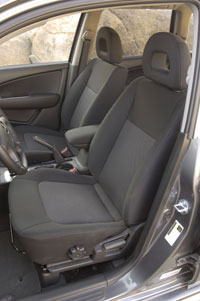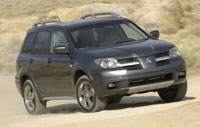 Taut and toned, the Mitsubishi Outlander looks bolder and more aggressive than its better-established competitors, the 2006 Toyota RAV4 and Honda CR-V. Outlander offers a manual transmission; the RAV4 and CR-V do not. And its aggressive pricing makes the Outlander an attractive alternative to the big-name brands.
Taut and toned, the Mitsubishi Outlander looks bolder and more aggressive than its better-established competitors, the 2006 Toyota RAV4 and Honda CR-V. Outlander offers a manual transmission; the RAV4 and CR-V do not. And its aggressive pricing makes the Outlander an attractive alternative to the big-name brands.Otherwise, Outlander is similar in size and character to the CR-V and RAV4. Like those two popular vehicles, Outlander is a car-based sport utility, with four doors and a roomy cargo area that's easily accessible. Like other small crossover sport-utes, Outlander offers elevated seating for better visibility.
We found the Mitsubishi Outlander smooth and quiet, and rock-steady at highway speeds. Outlander is neither tall nor tippy and its compact size helps it negotiate the often-hostile asphalt jungle.
All-wheel drive is available for improved traction and handling stability on snow and ice or gravel. For 2006, anti-lock brakes and seat-mounted side-impact airbags come standard on all models.
A new 2006 Outlander SE replaces last year's XLS. The SE combines the same content with more brightwork and bling-bling, inside and out. And for 2006, the Limited model adds automatic climate control to its list of standard conveniences.
Lineup
The 2006 Mitsubishi Outlander is available in three trim levels: LS, SE, and Limited. All come with a 160-horsepower, 2.4-liter four-cylinder engine. LS comes with a five-speed manual transmission but offers a four-speed automatic. Automatic transmission is standard on SE and Limited. All three models are available with front-wheel drive (2WD) or all-wheel drive (AWD).
Outlander LS ($17,799) and LS AWD ($19,899) come standard with air conditioning; cruise control; power windows and locks; power folding rearview mirrors; a height-adjustable steering wheel; height-adjustable driver's seat; a 140-watt, four-speaker AM/FM/CD audio system; analog clock; center console with storage; two 12-volt accessory outlets; 60/40 split, folding and reclining back seat; intermittent windshield and rear window wipers, and 16-inch steel wheels. A cargo cover, floor mats, keyless entry, and roof rails come standard on the AWD model and are optional on the 2WD model ($550).
SE ($20,670) and SE AWD ($23,429) are the new rugged-looking Outlanders, with body-color fender flares plus, silver roof rails and stanchions, silver inserts and crossbar in the front grille, a polished exhaust finisher and 17-inch bright-finish alloy wheels. SE trim also includes sporty seat fabric, see-through headrests. whiteface gauges and clock, and a leather steering wheel and shift knob. A sunroof and an improved 210-watt Infinity audio system with six-CD changer, MP3 playback, and new alphanumeric display are standard with AWD and optional as a package ($1400) with 2WD.
Limited ($23,629) and Limited AWD ($25,479) add heated leather seats, heated outside mirrors, and automatic climate control. The sunroof and 210-watt Infinity audio are standard.
Safety features that come standard include anti-lock brakes (ABS) and side-impact airbags. ABS helps the driver maintain control of the car in an emergency braking situation, while Outlander's seat-mounted side arbags are designed to provide protection to the torsos of the driver and front passenger in a side impact. These are in addition to the required frontal airbags. Three-point seatbelts for all five seating positions and child safety seat anchors come standard. Both front seats feature seatbelt pretensioner and force-limiter technology, which can help reduce injuries in an accident. So wear them.
Walkaround
Mitsubishi Outlander presents a bolder appearance than other sport utilities in this class. In comparison to the cute-utes, Outlander has a more muscular, masculine, aggressive appearance.
A wide nose section splits the grille and flows back over the hood. The aggressive look is enhanced by large, tinted headlight covers and fog lamps mounted at the edges of the bumper on the SE and Limited models. Gray cladding on the bumpers and side sills adds to the aggressive appearance, and the 16-inch wheels lend substance to even the base model. SE and Limited feature handsome body-colored cladding.
The aerodynamic design minimizes wind noise going down the road. Mitsubishi Outlander presents a wind-cheating, wedgy profile that's more slippery than the 2006 RAV4, CR-V, or Forester. Its standard rear spoiler and the optional roof rack with tubular rails give it a substantial appearance. Getting in is aided by well-designed door handles that are easy to grab.
Walkaround
Mitsubishi Outlander presents a bolder appearance than other sport utilities in this class. In comparison to the cute-utes, Outlander has a more muscular, masculine, aggressive appearance.
A wide nose section splits the grille and flows back over the hood. The aggressive look is enhanced by large, tinted headlight covers and fog lamps mounted at the edges of the bumper on the SE and Limited models. Gray cladding on the bumpers and side sills adds to the aggressive appearance, and the 16-inch wheels lend substance to even the base model. SE and Limited feature handsome body-colored cladding.
The aerodynamic design minimizes wind noise going down the road. Mitsubishi Outlander presents a wind-cheating, wedgy profile that's more slippery than the 2006 RAV4, CR-V, or Forester. Its standard rear spoiler and the optional roof rack with tubular rails give it a substantial appearance. Getting in is aided by well-designed door handles that are easy to grab.
Interior

The Mitsubishi Outlander offers a roomy and comfortable interior, a benefit of its long wheelbase. Getting in and out is easy. You neither have to climb up nor stoop down to get inside. The Outlander's h-point, what engineers call the distance between your hips and the ground when you are sitting in the vehicle, is designed to offer easy entry. Once seated, you have a commanding vantage similar to that in a minivan. And there's a good amount of headroom for taller drivers.
The seats use high-density foam padding and the standard cloth is nice. The driver's seat offers height adjustment and effective lumbar support. The Limited's leather seats feel a little firmer than the cloth. The passenger seat and the back seat are comfortable and the vehicle feels confident, making it a good place to spend the miles.
We found all controls easy to operate. The instrument panel features an analog clock in the middle of a large, titanium-texture trim panel. The clock is easy to set and has a black face in the LS model and a white face in the SE version. Instrumentation includes a large speedometer and tachometer. The SE comes with lightface gauges and appear easier to read; besides, they match better with the titanium. At night the gauges glow with orange lettering on black faces; the clock looks a little incongrous with its orange on white. Standard heating and air conditioning controls are plain and simple, easy to operate. A variety of storage pockets is available. Rubber retainer bands hold things securely in the lighted glove box.
The rear seat is designed with additional lumbar support. It's split 60/40. There's no need to remove the headrests before folding the rear seats. Folding the rear seats reveals an extended, though not perfectly flat, cargo area. There is 24.4 cubic feet of cargo room behind the rear seats, and 60.3 cubic feet with the seats folded down. The rear seat has three headrests and three sets of shoulder belts. It also has a fold-down center armrest with two cup holders.
A single rear liftgate makes getting into the cargo area easy. A thin, divided storage area beneath the cargo floor cover offers some convenient storage, and the cargo area includes grocery bag hooks and a 12-volt power outlet. The cargo floor is about 30 inches off the ground to ease loading and unloading. A rear cargo cover is available for the Outlander to hide valuables. Mitsubishi cleverly designed a place under the cargo floor to stash the cargo cover. Other SUVs don't provide such a place, so the cargo cover takes up space in the vehicle and in your garage and is susceptible to damage.
Driving Impressions

The Mitsubishi Outlander is smooth, quiet and comfortable. Its long wheelbase and carlike suspension work together to provide a comfortable ride. It isn't as smooth as a Honda CR-V and some road vibration can be felt through the steering wheel, but there's little road noise or wind noise. The primary sound that can be heard is wind noise from the large side mirrors, and we would not want to give them up because they offer an excellent view rearward. Big mirrors are good.
One of the first things we noticed about the Outlander is that it feels very stable at high speeds. We found it to be more stable than the CR-V in crosswinds and at higher speeds. (Keep in mind Mitsubishi has extensive race and rally experience.) The Outlander's 103.3-inch wheelbase (the distance between front and rear tires) is the same as that of the Honda CR-V, but longer than the Toyota RAV4 and Subaru Forester.
Outlander leans in corners, but handles well. Steering is on the slow side and there's a small amount of play, but it's easy to steer smoothly, providing a nice, comfortable ride for your passengers. It's easy to drive.
Braking is accomplished with four-wheel discs and ABS, which allows the driver to brake and steer at the same time in an emergency stopping situation. Our Outlander stopped promptly, calmly and quickly.
Outlander is no rocket, but its acceleration puts it square in the middle of the pack of compact, car-based SUVs. Mitsubishi's 2.4-liter four-cylinder engine is rated 160 horsepower, matching the output of the Honda CR-V and Toyota RAV4. Mitsubishi tuned the Outlander's engine to deliver the bulk of its torque at lower engine speeds. Part of the credit for being able to do this goes to Mitsubishi's MIVEC electronic variable-valve setup, which helps the engine to operate at peak power and efficiency throughout the rev range. A two-wheel-drive Outlander with five-speed manual transmission is rated by the EPA at 22/28 miles per gallon City/Highway.
The four-speed automatic transmission has a Sportronic manual shift feature. Shift into Drive and it works like a regular automatic transmission; or the driver can slide the shifter to one side to select gears manually.
Generally, we found two-wheel-drive Outlanders felt smoother and peppier than all-wheel-drive models. Indeed, we found the front-wheel-drive Outlander worked quite well for zipping down big-city freeways.
The Outlander is built on a rigid unibody chassis and benefits from Mitsubishi's extensive experience in international rallies. The Outlander benefits from such body-strengthening techniques as MASH seam welding and what Mitsubishi calls its RISE design (Reinforced Impact Safety Evolution). Much of this technology was developed from the company's winning efforts in the Paris-Dakar raid as well as its involvement in the World Rally Championship with the Lancer Evo.
Summary & Specifications
Mitsubishi Outlander equals its competitors in powertrain competence and efficiency. It's smooth and quiet. It feels stable at high speeds and handles well on winding roads. Its diminutive proportions make it easy to park and maneuver in tight, busy places. Outlander makes a strong styling statement in the compact sport-utility class. Available all-wheel drive adds capability and safety in wet or winter weather, but the front-wheel-drive model feels more agile and is a little more enjoyable to drive. Outlander offers carlike handling with roominess and versatility. [Source : automotive.com]
Post a Comment